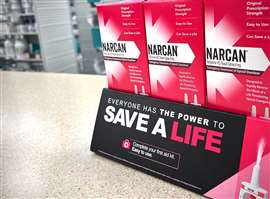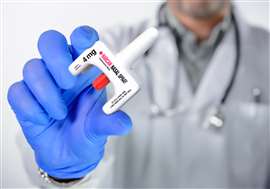Why employers are being urged to store Naloxone to counteract opioid overdoses on jobsites
05 December 2023
 Over-the-counter Narcan nasal spray (Image: Darwin Brandis via AdobeStock - stock.adobe.com)
Over-the-counter Narcan nasal spray (Image: Darwin Brandis via AdobeStock - stock.adobe.com)
It may seem hard to fathom for many nations outside of North America but with the US in the grip of a so-called ‘fourth wave’ of opioid addiction, construction employers are being urged to hold medications on jobsites to counteract the effects of an overdose.
Poisonings (which include overdoses) now rank as the leading cause of preventable deaths in the US, ahead of motor vehicle accidents.
In the 10-year period from 2011 to 2021, unintentional overdoses increased over 500% and overdoses account for over 9% of all workplace deaths, according to figures from the National Safety Council (NSC).
America’s ‘fourth wave’ of substance use disorder involves synthetic opioids like fentanyl, which are similar to morphine but cheaper and 50 to 100 times more potent.
That makes the risk of accidental overdose high and even one pill laced with fentanyl, perhaps taken inadvertently, is enough to kill.
Workplace danger
Speaking as part of a recent webinar organised by the Associated General Contractors of America (AGC), Janice Hartgens, vice president of the NSC’s Response Ready Workplace program, pointed out that overdose death rates are particularly high among people of working age (25-64), making this a workplace issue.
And unfortunately, construction is second-most-impacted sector when it comes to workplace overdoses, after trade, transportation and utilities.
That’s why Hartgens and Mandi Kime, director of safety services at AGC of Washington and co-chair of AGC of America’s national mental health and suicide prevention taskforce, both advocated construction employers implementing a Naloxone policy and programme on jobsites.
Naloxone is a drug that rapidly reduces or reverses the effects of opioid overdose and crucially helps to counter decreased breathing in people who have suffered an overdose. It is generally administered via a nasal spray of intermuscular injection and is sold under different brand names including its most commonly known name in the US, Narcan.
Explaining that the NSC wanted to tell the story of overdoses within construction workplaces and have an impact on reducing them, Hartgens said, “We understand that these industries are impacted by the potential of workplace injuries due to slips, trips, falls, musculoskeletal injuries and employees may be prescribed opioids that lead to a substance use disorder (SUD).”
 Image: Giovanni Cancemi via AdobeStock - stock.adobe.com
Image: Giovanni Cancemi via AdobeStock - stock.adobe.com
Kime pointed out that having a Naloxone programme was only part of the solution and that construction employers should also look at ways to reduce the stigma around substance abuse disorders and creating a safe place for people to seek help and get better.
Addressing employers, she asked, “Do you have all the programmes in place to help support your workforce to feel comfortable coming forward or if they end up having a positive drugs screen and need help?
“The AGC of America mental health and suicide prevention taskforce has developed a number of tools and resources relative to stigma, and coping and resilience strategies. We have challenges recruiting and retaining people in our industry. And one of the main factors that we can really impact here is having a total worker health approach, having psychologically safe workplaces, having programmes in place like a Naloxone programme to help support our workforce and encourage them and retain them and keep that talent within our organisation.”
Naloxone on site
Pointing out that Naloxone brands like Narcan and RiVive are now approved for over-the-counter use in the US, Hartgens said they were safe, effective and easy to administer.
And she urged employers to dispel fears they had about administering the medication. “People think: ‘Should I give Naloxone – I don’t know what is going on with this person.’ But it only affects someone if they are undergoing an opioid overdose and so it is the best choice if it is available,” she said.
However, she pointed out that even after being given Naloxone, people would still require immediate medical attention, even if they said they subsequently felt fine. That’s because, depending on the amount of opioids in their system, they may require multiple doses of Naloxone, which typically stays in the system for 30-90 minutes.
“By having Naloxone in the workplace, we are giving people a second chance at recovery,” she added. “There are people that say: ‘Well, if I have Naloxone in my workplace then people are going to use more opioids. But studies out there say that is not the case. If someone has a substance use disorder, they most likely had it before you had Naloxone in the workplace.”
Kime added that Naloxone on jobsites wouldn’t necessarily end up being beneficial only to an employer’s own workforce but to the myriad other people who pass through a jobsite, possibly even including clients..
She said, “Most of us are envisioning utilising that Naloxone for our own workers. But in construction we have such a unique set of conditions. We may have trade partners on site, clients and customers, and we may have the general public on site for a variety of different reasons.
“So a Naloxone programme could be saving the life of one of your workers, the life of a trade partner’s worker, a client, or a member of the general public.”
Availability and proposed legislation
Construction employers can obtain Naloxone though local harm reduction organisations, as well as health departments, and local pharmacies.
The NSC also has a deal with Narcan’s manufacturer Emergent that means purchases through NSC will result in charitable donation coming back to the organisation to help it to continue to provide resources for employers.
Meanwhile, the NSC is working on bipartisan legislation called Work to Save Lives Act H.R. 5420/S. 2948, introduced in the House of Representatives and the Senate. If passed, it would mandate that federal sites would hold stocks of Naloxone and train employees within workplace to use it. It would also provide guidance to public and private employers on how to access the medication and train employees.
Hartgens said the organisation is also working with state legislatures to replicate the legislation and hoped that this was something they could continue to work on next year when states go back into session.
Liability concerns
Hartgens said that one of the main barriers to more employers adopting Naloxone programmes was concerns around liability.
All 50 US states have Nalaxone access laws that mean it can be sold over the counter. But Good Samaritan laws, which offer legal protection to people who give reasonable assistance to those who are injured, ill, or in peril, vary by state.
She urged employers to understand how Good Samaritan laws worked in the state in which they operated. Companies that do decide to implement Naloxone policies should review them with legal professionals, she adviced.
Kime added, “Just remember that administering Naloxone to someone is a life-saving opportunity. Any one of us is one decision, painful event or prescription away from a potential SUD and it is really important to share with your teams that no person is beyond hope or help. It is a very tough time to be alive so if we can support people we really need to be doing that.”
She pointed to more resources on the Alliance for Naloxone Safety in the Workplace (ANSW) website, which offers employers sample policy language, training programmes, toolbox talks, and information on the legal landscape.
STAY CONNECTED



Receive the information you need when you need it through our world-leading magazines, newsletters and daily briefings.
CONNECT WITH THE TEAM









